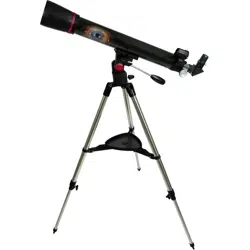Loading ...
Loading ...
Loading ...

6 | ENGLISH
60AZ TEL ESCOPE
YOUR FIRST ASTRONOMICAL OBSERVING SESSION
the Moon
Now you are ready to take your telescope out at night and do some real observing!
Let’s start with the Moon. The Moon takes about one month go through a complete phase cycle, from New Moon to Full
Moon and back again. Try observing it at different points during this cycle.
While you can observe the Moon any time it is visible in the night sky, the best time to view it is from two days after a New
Moon up to a few days before a Full Moon. During this period, you will be able to see the most detail in craters and lunar
mountain ranges. Consult a calendar to find out when the next New Moon will be.
1. With a clear view of the Moon, set up your telescope with the 20 mm eyepiece.
2. Turn on the finderscope and look through it to find the red dots.
3. Move the telescope until you can see the Moon through the finderscope’s window and both red dots are
centered on the Moon.
4. Look through the 20 mm eyepiece. Gently turn the focus knobs to adjust the sharpness of the image.
Unlike fixed targets on the ground, astronomical targets appear to move across the sky due to Earth’s rotation. When you
look at a celestial target in your telescope, such as the Moon, it will slowly drift across the field of view of your eyepiece. To
keep the object centered in the field of view, you will have to nudge the mount.
congratulationS! You haVe noW obSerVeD Your FirSt celeStial obJect!
To get a closer view of the Moon, replace the 20 mm eyepiece with the 10 mm eyepiece. It will give you more magnification,
making the Moon appear much larger. You may need to adjust the focus knobs when you change eyepieces to ensure you
are getting the sharpest image.
You can view many other celestial objects, such as planets, star clusters and nebulae using this same basic technique.
For more tips for about astronomical observing please visit
celestron.com/cosmos
There you will find comprehensive tips to help you get the most from your new telescope including:
• How to observe the planets
• How to locate and observe stars, double stars, star clusters
• How to observe deep-sky objects such as nebulae and galaxies
• How to choose a good location for astronomical observing
• How to evaluate sky conditions
Loading ...
Loading ...
Loading ...
